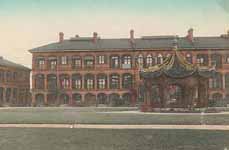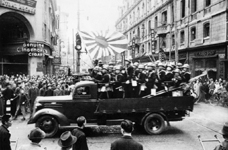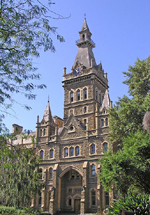Sinological Profiles
R H Mathews
13 July 1877 (Melbourne) - 16 Feb 1970 (Melbourne)Robert Henry Mathews was born in Melbourne, of a London father (William Mathews) and an Australian mother (Mary Whitlaw). William Mathews was a tinsmith who later worked for the Victorian Railways, an Australian governmental organization which originated in 1856 to take over failed local lines. Their son Robert was also raised along practical lines. During his training as a lithographer in the Working Men's College (which later evolved into the Royal Melbourne Institute of Technology), he became interested in the work of the Christian missionaries. After graduating, he set up his own printing business, but his interest in a missionary calling continued, and he abandoned the business in August 1906, at the age of 29, to join the China Inland Mission. He was at first thought to be too old to learn Chinese, but was eventually admitted (CIM at this period was accepting only about 1 in 10 of its applicants). After eighteen months of Bible instruction and ministerial apprenticeship in Adelaide, where he ministered to the city's outcast poor - the working man's equivalent of a theological school degree course - he sailed for China on 4 October 1908, first spending a short time at Shanghai headquarters. On 30 December 1908, he married another CIM Australian missionary, Annie Ethel Smith. The couple eventually had three children.
Mathews was short and slender, and of courteous manner. His preaching was said to have been "forceful and practical," but his innate inclinations were toward the intellectual; one contemporary described him as "round shouldered like a scholar." He was first assigned to two missionary stations in Hvnan, this being one of the "inland" provinces which were felt to be the special concern of the China Inland Mission. In 1915, he was transferred to Hweijou (Anhwei). There, as in Hvnan, he encountered "a peculiar lack of response to the Gospel message." It was in Anhwei that Mathews became seriously interested in the Chinese language, and began to acquire the special competence that would later distinguish him.
Back in Hvnan, he conducted Bible classes for the troops of the warlord Fvng Yw-syang, who were more receptive to the Gospel message; it was to this "Christian General" that the CIM looked to found a new moral order in China. Mathews subsequently traveled over Szchwan, again leading Bible classes, and also supervising the work of Chinese seminarians; that is, working a step back from the evangelical edge. Annie Ethel Smith died in 1920. Two years later, Mathews married Violet Ward, six years his junior. In 1926, he went back to Melbourne on what was meant to be a brief vacation, but the deteriorating political situation in China forced him to delay his return to Shanghai until February 1928.
In Shanghai, the CIM gave him an assignment which fitted his talents, and his moment in the Sinological sun began; it was to last for ten years. The first task was to revise Baller's Chinese-English Dictionary. With the assistance of his wife Violet, Mathews worked intensely on this daunting project, and in early 1931 the more than 1200-page manuscript was completed. The opening paragraphs of Mathews' Introduction, dated April 1931, tell how he had fulfilled his "revision" assignment:
Baller's Analytical Chinese-English Dictionary, now out of print, was first published in 1900. It has served a useful purpose, and many students of Chinese acknowledge their indebtedness to it, but the rapid changes which have taken place in China, with the influx of modern inventions and the advance of scientific knowledge, have brought in a wealth of new ideas, necessitating a corresponding number of new expressions. These things have made the old dictionary out of date, and mere revision would have been inadequate. Therefore, instead of revising the old book, a new dictionary has been compiled, keeping in view the object of the original work, "to supply the demand for a dictionary at once portable and inexpensive and at the same time sufficiently large to meet the wants of an ordinary student."
The number of Chinese characters included in the book has been increased to 7,785, not including different forms of the same character. This selection of characters should meet the needs of the average student, as most of the characters which have been added were not found in the founts of the Press and had to be specially engraved. The use of the characters has been illustrated by a greatly increased number of examples. In Baller's Dictionary there were about 40,000, while the present book gives over 104,000 illustrations drawn from the classics, general literature, magazines, newspapers, advertisements, legal documents, and many other sources. As far as possible, every use of a character has been illustrated by examples. Some of these expressions may have passed out of current use, but their inclusion in a dictionary is warranted by the fact that they occur in the literature of the period.
The sufficiency of that character vocabulary has been validated by more recent frequency studies, which identify the 5,000 characters of the Fenn dictionary as covering a large percentage of reading needs, whether classical or modern; the additional characters in Mathews supply most of the residue. There remain the next 40,000 characters, which are of sufficient rarity that they may safely be left in an unabridged dictionary (such as Morohashi) until needed. To put it in the most general terms, Mathews contains the vocabulary component of what a generally literate reader should know without having to look it up.
With this paragraph of Mathews' Introduction, the writers of dictionaries will find themselves in wry agreement:
The suggestions and requests which were received have been rather bewildering. "Many more characters must be added, as well as many more illustrative examples, but the book should be very much smaller than the present one, and also very much lighter." It reminds us of the old lady who is said to have asked the Bible Society if they could supply her with a pocket edition of the Scriptures in large type. . .
The dictionary went forth. Its quality was obvious, and its reception was favorable. CIM assigned Mathews to similarly modernize the Baller companion volume, a primer of the language. Years passed. In every one of them, Japanese pressure on China increased. The Marco Polo Bridge Incident of July 1937 marked a new level of Japanese intrusion into China, but Mathews was able to continue working.
In 1938 appeared his second and final Sinological contribution, the Kuoyü Primer, "Progressive Studies in the Chinese National Language," with CIM again as its publisher. It weighed in at 790 pages. In his May 1938 preface, Mathews outlined what he had done:
This series of progressive studies in the Chinese National Language or Kuoyü, is a successor to the well-known Mandarin Primer by F W Baller, which is now out of print. The general arrangement follows that of its predecessor, but with the exception of some reading-lessons which have been taken over from the old book, it is an entirely new production.
Many years of experience in correcting examination papers for beginners in the study of Chinese, led to the conclusion that an increased number of examples illustrating the use of the different idioms was desirable. To meet this need, examples have been culled from all sorts of books in Kuoyü by modern writers, as well as from the Chinese Bible and other sources.
The old Mandarin Primer was divided into thirty lessons, each beginning with a vocabulary of new characters and expressions; there was also an additional vocabulary after every fifth lesson, as well as much new matter given in footnotes to the reading-lessons. The term 'lessons' was scarcely correct, because each of them contained much more than could be learned in one 'lesson,' or indeed in several 'lessons.' In this book, each of the sections into which it is divided deals with one point of idiom or grammar, and is thus a real "lesson.' These sections have been numbered from 1 to 262. Here and there, between these sections, vocabularies of new characters and expressions have been introduced, totaling forty in all. This gives a list of 1,354 new characters, averaging about 33 to each vocabulary, and a list of 2,030 expressions.
There are lists of vocabulary by topic, English indexes not only to words but to examples, and a phonetic index to the Chinese vocabulary. Pedagogically admirable. In case you were curious, section 262 deals with onomatopoetic and affective reduplicates. The Chinese government was still in the process of settling on a standard language, and official policy was to abandon the former compromise between the speech of Kaifeng and Peking, and to follow an exclusively Peking standard. Mathews chose to retain compatibility with his Dictionary, and comments:
. . . These are examples of the slight changes made by the arbitrary unification of the language, but they are not of vital importance to the foreign student, as, after all, the sounds as given in the earlier dictionary were regarded as Standard Kuoyü only a few years ago, and they are really nearer to what may be termed 'current speech' than pure Pekingese, with all its localisms, can ever be.
A similar policy of benign neglect was adopted toward the tonal spelling of Y R Chao (the GR romanization), which had recently officially adopted by the Chinese government, "as this system has not yet come into popular use." Nor has it ever. Such were still the luxuries of decision in 1938.
The external tempo now picked up. The Japanese declaration of war on America at the end of 1941 further polarized relations among Japan, China, and foreign residents in China.
Shanghai was a virtually international city, with its nearly extraterritorial legation zones. It was entered by the Japanese Army in 1941, but for a time was handled with circumspection. At at the end of 1942, this changed (a moment that Reifler experienced in a different way, and in a different part of Shanghai), and CIM, which had already moved its quarters within Shanghai in 1931, now relocated more drastically, to Chungking in Szchwan, where the Nationalist Chinese government had also taken refuge. In 1943, the previous CIM compound in Shanghai was taken over by Japanese occupation troops, and the printing blocks as well as the copies of Mathews' own revision of his Dictionary were destroyed. That left only the original edition, and the lack of copies of that edition suddenly became an urgent matter for the English-speaking nations involved in the Pacific War. Within a few months, Harvard University Press had issued a reprint of the original Dictionary. The March 1943 Foreword begins thus:
With books no longer coming from the Far East, the need for Chinese dictionaries in this country has grown from chronic to acute. To answer the immediate demands of American students, the Harvard-Yenching Institute has undertaken to revise and reprint two practical dictionaries, (1) C H Fenn's Pocket Dictionary, which appeared in November 1942, and (2) the present Chinese-English Dictionary by R H Mathews, both photolithographed reproductions.
Within the necessary limitations of a photographic edition, and as far as interstices of the original edition allow, errors have been corrected, pronunciations and definitions revised, and new entries inserted - in all amounting to some 15,000 items. A whole Introduction on Pronunciation has been added, and a list of syllabic headings is included for quick reference, since the original order of syllables is not strictly alphabetic. . .
Mr M Y Wang is responsible for the mechanical details of preparing the book for reproduction, Dr Y R Chao has written the Introduction and has checked the pronunciation of all the entries, and both have taken part in the revisions.
From this point, the histories of Mathews and his Dictionary diverge.
In April 1943, Mathews himself, along with Violet, was interned by the Japanese at the Lunghwa Camp, the former campus of the Kiangsu Middle School, seven miles southwest of Shanghai and a mile from the Whangpoo River. With them were missionaries both Protestant and Catholic, businessmen and their families, and the officers and crew of the SS President Harrison, among hundreds of others. At 42 acres, this was the largest of all the internment camps in China, and one of the bleakest. Most buildings were of concrete, three of them were ruined, and the landscape was desolate, with "only one tree." The prospect was not improved by the typhoon of 11 August 1943, which blew the roof off the West Dining Hall, and effectively destroyed that building; it also unroofed several small residence houses. A few Americans were repatriated in September of that year. The rest settled down to wait out the war. By and large, conditions were manageable. Ten acres were devoted to communally farmed vegetable gardens, and there were also a few private gardens. Hot showers were available, though since the well pumps were slow, the showers had to be brief. The animal population included two cows, hens, a flock of goats, and sixty pigs. Communications with the outside were possible, and the Shanghai Dairy donated an additional Holstein calf; eventually there was enough milk for all the camp children to get half a pint a day. Communications with the outside worked both ways, and there were four successful escapes, plus a few failed attempts, during the next two years. Nor were high spirits confined to escape attempts. One internee recalls that the single men, who were quartered in the Assembly Hall, "raised so much hell at night, laughing and telling jokes, that one night a guard took a potshot into our window to stop us from making so much noise." As at some other camps, the guards were not Japanese Army soldiers, but were drawn from the Consular Police. The bullets, however, were real.
Japan surrendered in August 1945, the Swiss temporarily took over the management of the Lunghwa camp, and the internees left later that month. Mathews, then 68, returned to Melbourne for a third and final time, to a well earned retirement. In 1946, Violet published a an illustrated 45-page pamphlet about life in internment, called Lunghwa Days and Ways. In 1948 there appeared A Life on Fire, her full-length biography of Alice Macfarlane, an admired superior in the China Inland Mission and the Supervisor of the Mission Language School at Yangchow.
China itself continued to evolve, chiefly through the mechanism of a closely watched civil war, and to loom large in the Australian consciousness. Mathews' linguistic skills were known to the Australian Department of Defense, and in 1948 he was recruited to work part time on the translation of archival material and the compilation of glossaries. In 1951, this was increased to full time, Violet assisting him in the work.
Three years passed. Violet died in 1954. Mathews himself retired from his second career in 1957, at the age of 80. Five years later, in 1962, his remarkable linguistic achievement, based not on formal training but on natural gifts and strenuous application, was honored by the conferral of an honorary Doctor of Letters degree from the University of Melbourne.
Mathews died on 16 February 1970, aged 93. His remains were cremated, as he had requested.
The Dictionary went marching on. In 1972, Chow Tse-tsung of the University of Wisconsin published a different character index for it, and in that same year Olof Bertil Anderson of Lund University published a 210-page Companion Volume to it. In 1978 came Edward Schafer's Combined Supplements to Mathews, published from the Department of Oriental Languages at Berkeley, and following up on the same author's 1966 article "Thoughts on a Students' Dictionary of Classical Chinese." The Supplements ran to 78 pages. Anderson's Companion went into a 335-page third revision in 1988.
And the Dictionary, aged 77 as of this writing, continues in use, not really adequate for the student of classical Chinese, but also not yet surpassed by anything which can serve equally well as a first recourse for that segment of the English-speaking Chinese readership. That need continues. But so, in the meantime, should Sinology's gratitude to one of its less sung pioneering figures.
E Bruce Brooks
References
- R H Mathews. A Chinese -English Dictionary / Compiler for the China Inland Mission. Shanghai, China Inland Mission and Presbyterian Mission Press, 1931
- R H Mathews. Kuoyü Primer: Progressive Studies in the Chinese National Language. Shanghai, China Inland Mission, 1938
- Mathews' Chinese-English Dictionary. Revised American Edition. Harvard 1943
- Violet Mathews. Lunghwa Days and Ways. Spectator [Melbourne] 1946
- Violet Mathews. A Life on Fire. Bacon [Melbourne] 1948
- Edward H Schafer. Thoughts on a Students' Dictionary of Classical Chinese. MS v25 (1966) 197-206
- Chow Tse-tsung. A New Index to Mathew's Chinese-English Dictionary, based on the "Chung" system for Arranging Chinese Characters. University of Wisconsin 1972.
- Olov Bertil Anderson. A Companion Volume to R H Mathews' Chinese-English Dictionary. Lund, Studentlitteratur 1972
- Edward H Schafer. Combined Supplements to Mathews. Berkeley, Department of Oriental Languages 1978
- Olov Bertil Anderson. A Companion Volume to R H Mathews' Chinese-English Dictionary. 3rd edition. Lund, Studentlitteratur 1988
- Australian Dictionary of Biography entry for R H Mathews by Arthur Huck
Sally Burdon and Violet Ward's great-neice Judy Ward contributed to this profile.
9 Oct 2008 / Contact The Project / Exit to Sinology Page


